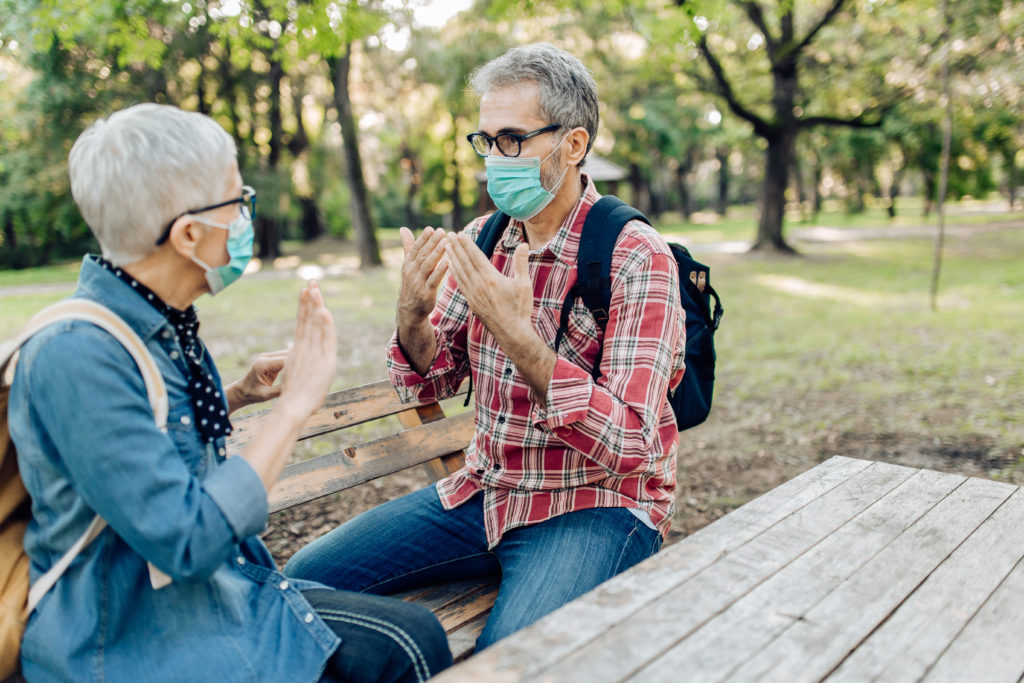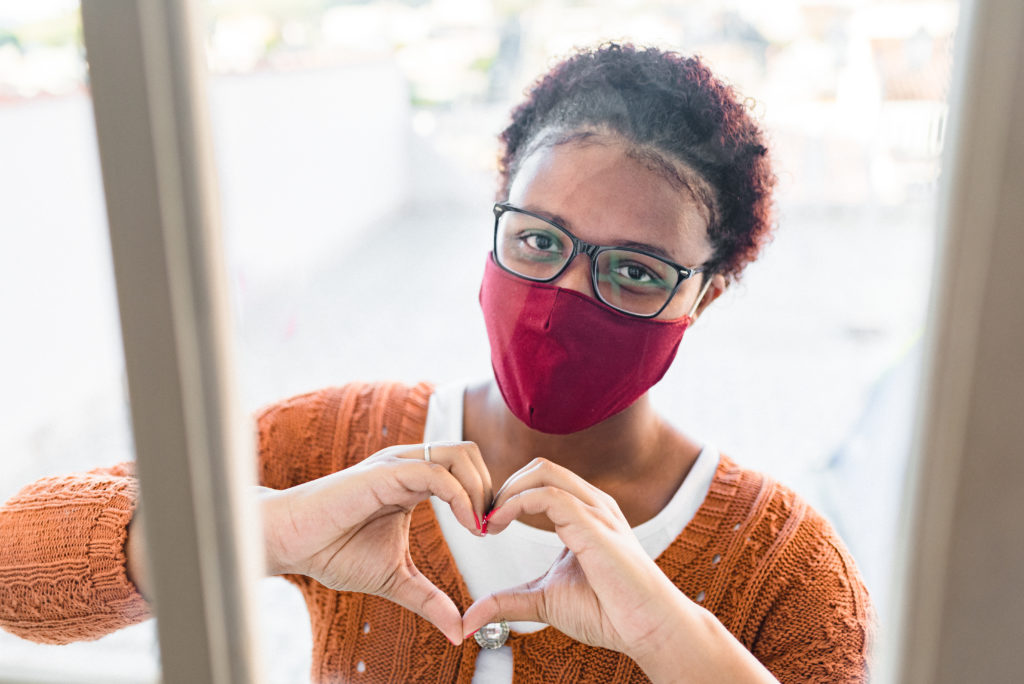Holly Smith, ASLdeafined Director of Communications, November 2020

It is no secret that the coronavirus pandemic has led to a number of new experiences for the world population. Several months into the health crisis much has been shared by many about the adjustments to daily life. One of the emerging themes across all nations and peoples has been isolation. One of the tragedies of Covid-19 is the likelihood of dying alone. These are heavy matters that weigh significantly on the human race as individuals fear for their own safety and worry over loved ones. Now imagine this…
English is your second language. You rely heavily on facial expressions and mouth movements to communicate. Interpreters or family members are of significant help to you when engaging in vital life business. You are starting to exhibit some symptoms of Covid-19. None of the information tools you rely on are available. Healthcare workers are wearing masks, face shields and goggles that obscure their lips and expressions. In-person interpreters cannot be present due to limiting interactions and social distancing. Family members are no longer allowed to accompany you to the hospital. You are alone, frightened and do not have access to the full range of information needed to navigate complicated times.
Facing challenges and breaking down walls is nothing new to the Deaf and Hard of Hearing (D&HH) Community. Yet, adding the layer of a global pandemic also adds a layer of stress. Covid-19 has widened unfortunate gaps that already existed for too long, further alienating the D&HH population. D&HH individuals use many types of communication to share and receive messages. Whether it is reading lips, noting expressions and gestures, utilizing sign language and more, each method paints a full picture of what is being conveyed. Take one of those elements away by, for instance, covering someone’s mouth with a facemask, and a significant part of the overall message is blocked. Facial expressions show context, so without them the story is incomplete. As Daisy Rivenbark of North Carolina said in a news interview, “Putting a mask on is like putting up a wall.” Jennifer Schwartz of Michigan shared in an email, “I have struggled for years to understand people and what they say… since COVID-19 and having to wear a mask it has made things so much harder, struggling to understand people and the struggle to be heard as well.”
Much of the problem resides in inefficiencies and misunderstandings inherent in many of the hearing population’s longstanding practices. Attempts to close the communication gap were wanting prior to the arrival of the virus. The use of closed captioning is a perfect example of a supposed fix that comes up short for the D&HH Community. First, it is not required in many cases. Howard A. Rosenblum, CEO of the National Association of the Deaf explains in a series of statements, “The Federal Communications Commission (FCC) mandates television captioning, but the rules are different for live broadcasts. National news must be captioned, but most local news isn’t. And while the FCC requires live captioning in emergencies and disasters, that requirement is not always followed.” He goes on to share, “Internet live streams aren’t much better… captions aren’t always accurate because many stations generate their captions with a computer program, rather than a trained expert, often without editing to ensure accuracy… that often makes captioning useless for the most part.” In addition to access, the language barrier is an issue. American Sign Language (ASL) has a completely different structure and grammar than English. As Diana Kautzky, President of Deaf Services Unlimited in Iowa, notes “ASL uses space, it uses eye gaze, facial expressions and intensity of the sign. All of those things that you can’t get when you’re providing a linear sentence. The translation is very different. You can’t just say you’ll provide captioning and that’s good enough.” Jennifer Schwartz of Michigan relayed her experience with this as well, noting that when she was accepted at a university, “all of their classes were online via Zoom… I have been trying to get closed captioning. The first 6 weeks of class I had nothing as the company (the university) hired did not have captionists to do the work. I was disappointed and frustrated as I was missing so much.”
Unfortunately, the situation with interpreters is not much better. Often, they are not included in reports or live updates or, when they are present, can sometimes be cut from the frame. Both Governor DeSantis of Florida and the White House have been sued for failing to include sign language interpreters in press conferences. The National Association of the Deaf brought suit against the Trump Administration for violating the Americans with Disabilities Act for not providing this vital source of communication. This ignores the needs of about 15 percent of the U.S. population, over 37 million adults, who report some trouble hearing according to the National Institutes of Health.

Situations like substandard captioning and lack of interpreters are just a few examples of how the pandemic has highlighted issues that already existed regarding access to reliable information for the D&HH. This is particularly concerning during a health crisis when knowledge is critical to human health and safety. Although the D&HH population is certainly accustomed to advocating for themselves, mainstream society is long overdue to make an authentic commitment to improving the situation. Indeed, everyone is challenged by the current onslaught of news and changes in how the most mundane tasks and errands are completed. Yet, D&HH individuals have shared that amidst Covid-19 it can be awkward at best, usually frustrating, and often downright exhausting. To complicate matters, the challenges the D&HH are experiencing are every bit as diverse as the many tools used by the community to connect.
Although the coronavirus has compounded the issues of an already flawed civilization, some efforts have been made to avoid deepening the divide. Sign language interpreters are increasingly being recognized as essential workers. Whether or not interpreters are available, efforts have been made to provide masks with a clear window for health care providers to improve their ability to discuss matters with D&HH patients. These facemasks are not without problems like glare and fogging up, but they are a step toward recognizing the need to be more inclusive. Organizations such as DHH-RERC (Deaf and Hard of Hearing Technology Rehabilitation Engineering Research Center) are providing helpful resources to assist people who may find themselves in the scenario outlined at the beginning of this article.
Technology plays a key role in seeking solutions, and D&HH citizens have shared that they are now tied to their smartphones more than before, with various apps providing aide, albeit imperfectly. Tools like live transcription are gaining attention with online meeting programs like Google Meet, but glitching and lagging of servers and computers can sometimes make that less than ideal. Jennifer Schwartz provided insight on this from her perspective as a social worker working with clients, explaining “I would have to do hour meetings with my clients and that was a struggle… they have disabilities, plus trying to work with them either over Telehealth or my phone,” going on to share that without the option of video, it is even more difficult to completely understand clients as she relied on facial expressions and reading lips when they would previously meet face to face. Overall, no matter how overburdened society may be at present, it is more important than ever to work toward authentic inclusion.
Elevated levels of anxiety are not uncommon in these times, but circumstances have certainly exacerbated these feelings for the D&HH. As stated in an article from Mother Jones magazine, “minor inconveniences for most people have become fundamental disruptions for many people who are Deaf or Hard of Hearing.” This piece also reflected that, “as Deaf and Hard of Hearing individuals adjust to the social code of the pandemic, the spaces where they might feel most at home – like schools or social organizations for Deaf people – have also disappeared.” How information is gathered is another matter that hearing individuals may take for granted as it is readily available in a variety of forms. Yet, something so seemingly simple can be problematic for marginalized populations during an emergency. As Jan Withers of North Carolina’s Division of Services for the Deaf and the Hard of Hearing expressed, “The challenge in the Deaf community is with their access to information,” pointing out that “People who hear can get incidental knowledge from the television, radio or conversation snippets. Not so for those with hearing loss. These realities add additional weight to an already heavy load for a population that has continuously lobbied for a place at the table.

This began with isolation and ends with patience. The other obvious message that ran through every resource consumed on this topic is the importance of patience. This is a quality that would benefit all populations during a pandemic, but is especially hoped for by the D&HH individuals quoted and interviewed. As one Deaf gentleman of Mississippi, Ralph Vice, so straightforwardly and wisely put it, “There are many barriers that we’ve been used to overcoming all of our life, and being able to understand everybody’s perspective in that way… is key to being able to work together.”
As the hearing author of this article, I would never presume to fully understand what D&HH Americans have had to endure before the Covid-19 crisis, let alone during it. Yet, it is my hope that this piece will open the eyes of others and lead to the behaviors wished for in the readings I used to prepare for this writing. Simply… be patient, be kind, take time to consider things through another’s lens. Perhaps then, despite everything, we can move closer together instead of farther apart, whatever our differences.
[NOTE: I did reach out to local members of the D&HH Community seeking input for this article. My deepest gratitude to Jennifer Schwartz for answering this call. Her quotes were taken from a subsequent email exchange. If you are Deaf or Hard of Hearing and willing to provide your perspective or share your experience as well, I enthusiastically welcome your voice. If I gather additional insights, I intend to add an afterword with the comments, concerns, testimonials or whatever else you and the individuals I have contacted may express is needed to raise awareness or build understanding on this topic. I may be contacted via email at: holly@asldeafined.com.]
Information for this piece gathered from…
America’s Pandemic Response Is Creating Major Hurdles for Many Deaf People by Will Peischel, Mother Jones, August 5, 2020: https://www.motherjones.com/politics/2020/08/americas-pandemic-response-is-creating-major-hurdles-for-many-deaf-people/
Challenges for the Deaf During the Pandemic by Rachel Boyd, Spectrum News One, Wilmington, NC, September 28, 2020: https://spectrumlocalnews.com/nc/charlotte/news/2020/09/28/challenges-for-the-deaf-during-the-pandemic
COVID-19 Accentuates Barriers for the Deaf and Hard of Hearing by Liora Engel-Smith, North Carolina Health News, April 1, 2020: https://www.northcarolinahealthnews.org/2020/04/01/covid-19-deaf/
Deaf Community Facing Challenges During Pandemic by KIRO 7 News Staff, Seattle, WA, April 24, 2020: https://www.kiro7.com/news/local/deaf-community-facing-challenges-during-pandemic/5CPCHNC54ZEQFLX24G523RYHZ4/
Deaf and Hard of Hearing Iowans Face Accessibility, Inclusion Gaps During Coronavirus Pandemic by Shelby Fleig, Des Moines Register, September 4, 2020: https://www.desmoinesregister.com/story/news/2020/09/04/deaf-and-hard-hearing-iowans-face-new-accessibility-inclusion-gaps-during-covid-19-pandemic/3407848001/
Deaf/Hard of Hearing Technology Rehabilitation Engineering Research Center – How Do Deaf, Hard of Hearing and Deaf-Blind Communicate at the Hospital During COVID-19? https://www.deafhhtech.org/rerc/how-do-deaf-hard-of-hearing-deafblind-communicate-with-doctors-nurses-and-staff-at-the-hospital-during-covid-19/
For the Deaf, Social Distancing Can Mean Social Isolation by Derrick Bryson Taylor, New York Times,
June 4, 2020: https://www.nytimes.com/2020/06/04/us/coronavirus-deaf-culture-challenges.html
National Center on Deaf-Blindness – Accessing Services During the Pandemic, April 2020: https://www.nationaldb.org/for-families/learning-resources/family-topics/services-during-pandemic/
Pandemic Brings New Technology, New Challenges for Deaf Community by Joyce Philippe, WLOX News, Ocean Springs, MS(?), May 31, 2020: https://www.wlox.com/2020/05/31/pandemic-brings-new-technology-new-challenges-deaf-community/
Pandemic Creates Challenges for Deaf, Hard-of-Hearing Community by Sheli Muñiz, NBC Miami News, September 2, 2020: https://www.nbcmiami.com/news/local/pandemic-creates-challenges-for-deaf-hard-of-hearing-community/2287291/
The Pandemic Made Life Harder for Deaf People, The Solutions Could Benefit Everyone by Tanya Basu, MIT Technology Review, May 28, 2020: https://www.technologyreview.com/2020/05/28/1002314/clear-mask-captioning-live-transcription-deaf-coronavirus-pandemic/